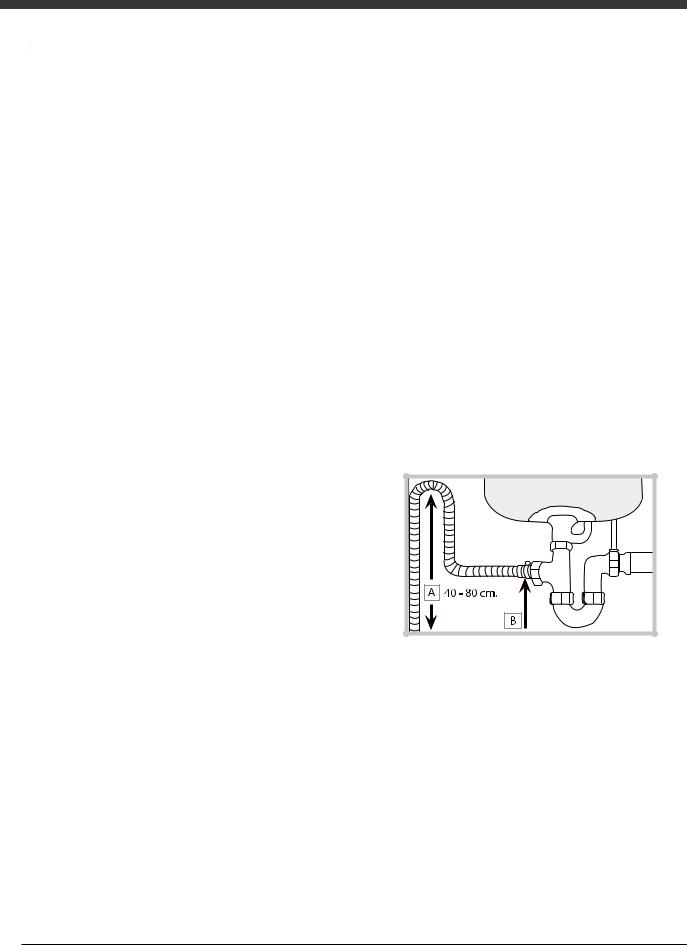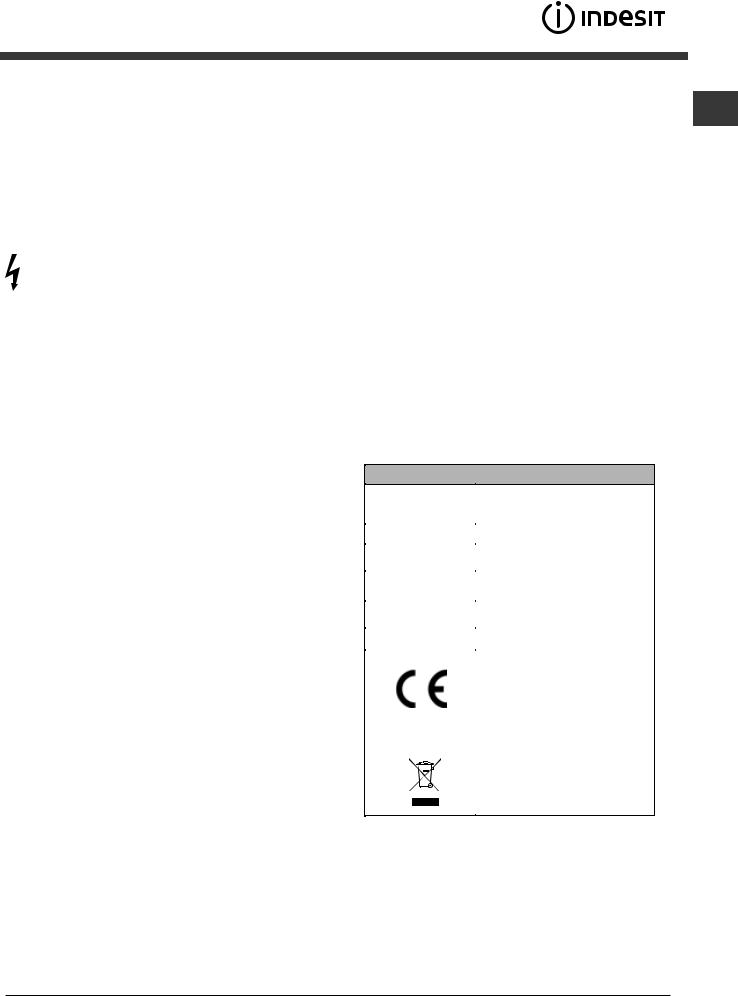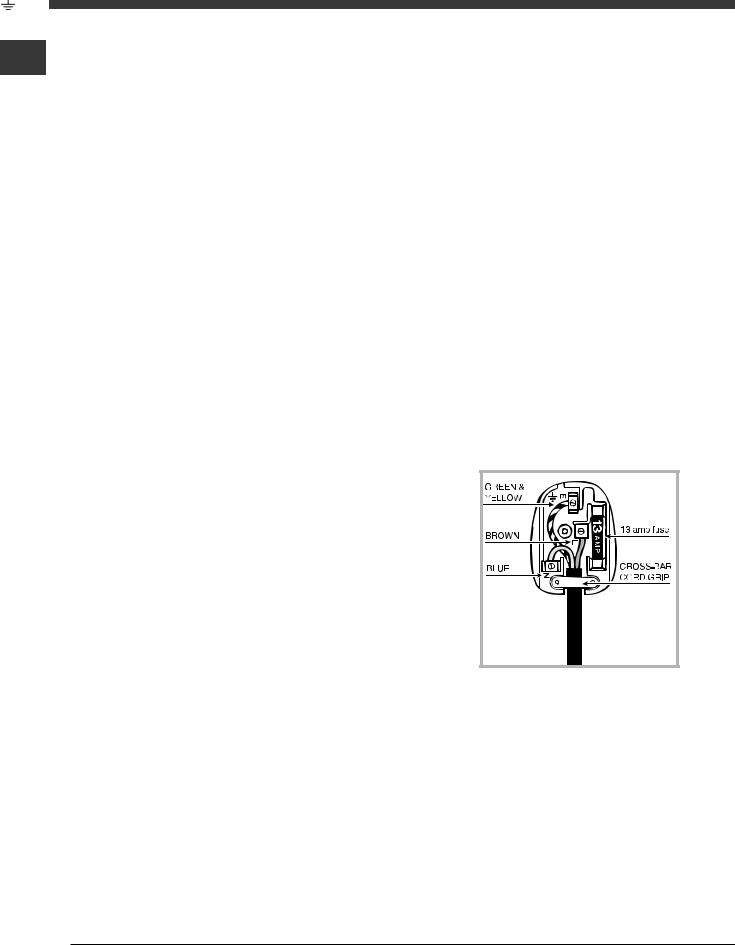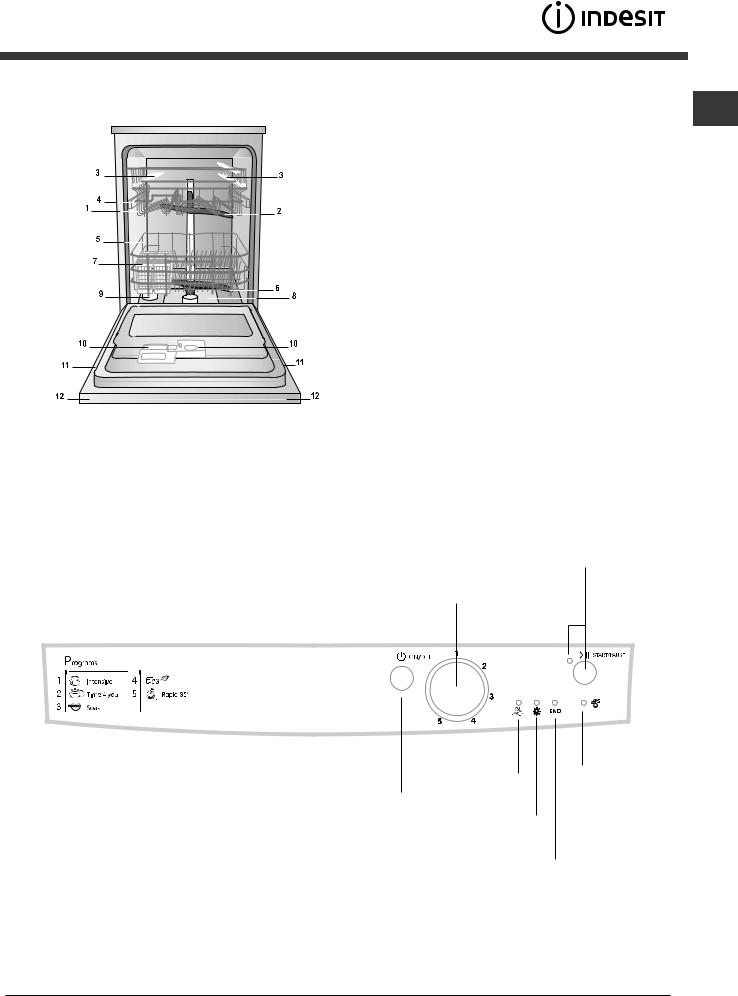Indesit IDF 125 User Manual

Operating instructions
DISHWASHER
EN
English, 1
Contents
Installation, 2-3-4
Positioning and levelling
Connecting the water and electricity supplies Advice regarding the first wash cycle Technical data
Electrical connection
|
Description of the appliance, 5 |
|
Overall view |
|
Control panel |
|
Loading the racks, 6 |
|
Lower rack |
|
Cutlery basket |
|
Upper rack |
|
Start-up and use, 7 |
IDF 125 |
Starting the dishwasher |
Measuring out the detergent
Wash options
Wash cycles, 8
Table of wash cycles
Rinse aid and refined salt, 9
Measuring out the rinse aid
Measuring out the refined salt
Care and maintenance, 10
Shutting off the water and electricity supplies
Cleaning the dishwasher
Preventing unpleasant odours
Cleaning the sprayer arms
Cleaning the water inlet filter
Cleaning the filters
Leaving the machine unused for extended periods
Precautions and advice, 11
General safety
Disposal
Saving energy and respecting the environment
Troubleshooting, 12
Guarantee, 13
After Sales Service, 14

Installation
EN |
|
|
Keep this instruction manual in a safe place for |
|
future reference. If the appliance is sold, given away or |
||||
|
||||
|
moved, please ensure the manual is kept with the |
|||
|
machine, so that the new owner may benefit from the |
|||
|
advice contained within it. |
|||
 Please read this instruction manual carefully: it contains important information regarding the safe installation, use and maintenance of the appliance.
Please read this instruction manual carefully: it contains important information regarding the safe installation, use and maintenance of the appliance.
 If the appliance must be moved at any time, keep it in an upright position; if absolutely necessary, it may be tilted onto its back.
If the appliance must be moved at any time, keep it in an upright position; if absolutely necessary, it may be tilted onto its back.
 This appliance is intended to be used in household and similar applications such as:
This appliance is intended to be used in household and similar applications such as:
-staff kitchen areas in shops, offices and other working environments;
-farm houses;
-by clients in hotels, motels and other residential type environments;
-bed and breakfast type environments.
Positioning and levelling
1.Remove the appliance from all packaging and check that it has not been damaged during transportation.
If it has been damaged, contact the retailer and do not proceed any further with the installation process.
2.Check the dishwasher by placing it so that its sides or back panel are in contact with the adjacent cabinets or
even with the wall. This appliance can also be recessed under a single worktop* (see the Assembly instruction
sheet).
3.Position the dishwasher on a level and sturdy floor. If the floor is uneven, the front feet of the appliance may be adjusted until it reaches a horizontal position. If the appliance is levelled correctly, it will be more stable and much less likely to move or cause vibrations and noise while it is operating.
4.Adjust the height of the rear foot from the front of the appliance* on the central lower part of the dishwasher, turning a hexagonal spanner (red color) with an opening of 8 mm in a clockwise direction to increase the height
or in an anticlockwise direction to decrease the height.
Connecting the water and electricity supplies
 Connection to the water and electricity supplies should only be performed by a qualified technician.
Connection to the water and electricity supplies should only be performed by a qualified technician.
 The dishwasher should not stand on top of the water hoses or the electricity supply cable.
The dishwasher should not stand on top of the water hoses or the electricity supply cable.
 The appliance must be connected to the water supply network using new hoses.
The appliance must be connected to the water supply network using new hoses.
Do not use old hoses.
The water inlet and outlet hoses and the electricity supply cable may be positioned towards the right or the left in order to achieve the best possible installation.
Connecting the water inlet hose
•To a suitable cold water connection point: before attaching the hose, run the water until it is perfectly clear so that any impurities that may be present in the water do not clog the appliance; after performing this operation, screw the inlet hose tightly onto a tap with a ¾ gas threaded connection.
•To a suitable hot water connection point: your dishwasher may be supplied with hot water from the mains supply (if you have a central heating system with radiators) provided that it does not exceed a temperature of 60°C.
Screw the hose to the tap as described for connection to a cold water supply.
 If the inlet hose is not long enough, contact a specialist store or an authorised technician (see After Sales Service).
If the inlet hose is not long enough, contact a specialist store or an authorised technician (see After Sales Service).
 The water pressure must be within the values indicated in the Technical data table (see adjacent information).
The water pressure must be within the values indicated in the Technical data table (see adjacent information).
 The hose should not be bent or compressed.
The hose should not be bent or compressed.
Connecting the water outlet hose
Connect the outlet hose (without bending it) to a drain duct with a minimum diameter of 4 cm.
The outlet hose must be at a height ranging from 40 to 80 cm from the floor / surface where the dishwasher rests (A).
Before connecting the water outlet hose to the sink drain, remove the plastic plug (B).
* Only available in selected models.
2

Anti-flooding protection
To ensure floods do not occur, the dishwasher:
- is provided with a special system which blocks the water supply in the event of anomalies or leaks from inside the appliance.
Some models are also equipped with the supplementary safety device New Acqua Stop*, which guarantees antiflooding protection even in the event of a supply hose rupture.
WARNING: HAZARDOUS VOLTAGE!
Under no circumstance should the water inlet hose be cut as it contains live electrical parts.
Electrical connection
Before inserting the plug into the electrical socket, make sure that:
•The socket is earthed and complies with current regulations.
•The socket can withstand the maximum load of the appliance, which is indicated on the data plate located on the inside of the door (see chapter entitled Description of the appliance).
•The power supply voltage falls within the values indicated on the data plate on the inside of the door.
•The socket is compatible with the plug of the appliance. If this is not the case, ask an authorised technician to replace the plug (see Assistance); do not use extension cables or multiple sockets.
 Once the appliance has been installed, the power supply cable and the electrical socket should be easily accessible.
Once the appliance has been installed, the power supply cable and the electrical socket should be easily accessible.
 The cable should not be bent or compressed.
The cable should not be bent or compressed.
 If the power supply cable is damaged, it must be replaced by the manufacturer or its Technical Assistance Service in order to prevent all potential hazards. (See After Sales Service)
If the power supply cable is damaged, it must be replaced by the manufacturer or its Technical Assistance Service in order to prevent all potential hazards. (See After Sales Service)
 The Company shall not be held responsible for any incidents that occur if these regulations are not observed.
The Company shall not be held responsible for any incidents that occur if these regulations are not observed.
Anti-condensation strip*
EN
After installing the dishwasher, open the door and stick the adhesive transparent strip under the wooden shelf in order to protect it from any condensation which may form.
Advice regarding the first wash cycle
After the appliance has been installed, immediately before running the first wash cycle, completely fill the salt dispenser with water and add only then approximately 1 kg of salt (see chapter entitled Rinse aid and refined salt). The water may overflow: this is normal and is not a cause for concern. Select the water hardness value (see chapter entitled Rinse aid and refined salt). - After the salt has been poured into the machine, the LOW SALT indicator light* switches off.
 If the salt container is not filled, the water softener and the heating element may be damaged as a result.
If the salt container is not filled, the water softener and the heating element may be damaged as a result.
Technical data
Dimensions |
width 60 cm |
|
height 85 cm |
||
|
depth 60 cm |
|
Capacity |
12 standard place-settings |
|
|
|
|
Water supply |
0,05 ÷ 1MPa (0.5 ÷ 10 bar) |
|
pressure |
7,25 – 145 psi |
|
Power supply |
See appliance data plate |
|
voltage |
||
|
||
|
|
|
Total absorbed |
See appliance data plate |
|
power |
||
|
||
Fuse |
See appliance data plate |
|
|
|
|
|
This dishwasher conforms to the |
|
|
following European Community |
|
|
Directives: |
|
|
-2006/95/EC (Low Voltage) |
|
|
-2004/108/EC (Electromagnetic |
|
|
Compatibility) |
|
|
-2005/32/EC (Comm. Reg. |
|
|
1275/2008) (Ecodesign) |
|
|
-97/17/EC (Labelling) |
|
|
-2002/96/EC (Waste Electrical |
|
|
and Electronic Equipment) |
|
|
(WEEE) |
* Only available in selected models.
3

Electrical Connection
Electrical Connection
EN If your appliance is supplied with a 13 amp. fused plug it can be plugged into a 13 amp socket for immediate use. Before using the appliance please read the instruction below.
 WARNING: THIS APPLIANCE MUST BE EARTHED.
WARNING: THIS APPLIANCE MUST BE EARTHED.
THE FOLLOWING OPERATIONS SHOULD BE CARRIED OUT BY A QUALIFIED ELECTRICIAN.
Replacing the fuse:
When replacing a faulty fuse, a 13 amp ASTA approved fuse to BS 1362 should always be used, and the fuse cover re-fitted. If the fuse cover is lost, the plug must not be used until a replacement is obtained.
Replacemente fuse covers:
If a replacement fuse cover is fitted, it must be of the correct colours as indicated by the coloured marking or the colour that is embossed in words on the base of the plug. Replacements can be obtained directly from your nearest Service Depot.
Removing the plug:
Ifyour appliance has a non-rewireable moulded plug and you should wish to remove it to re-route the mains cable through partitions, units etc., please esure that either:
-the plug is replaced by a fused 13 amp re-wireable plug bearing the BSI mark of approval
-or:
-the mains cable is wired directly into a 13 amp cable outlet, controlled by a switch, (in compliance with BS 5733) which is accessible without moving the appliance.
Disposing of the plug:
Ensure that before disposing of the plug itself, you make the pins unusable so that it cannot be accidentally inserted into a socket.
Instruction for connecting cable to an altenative plug:
Important: the wires in the mains lead are coloured in accordance with the following code:
Green & Yellow |
- Earth |
Blue |
- Neutral |
Brown |
- Live |
 CAUTION:
CAUTION:
- Once the appliance has been installed, the electrical plug and socket should remain accessible.
 - The Company shall not be held responsible for any incidents that occur if these regulations are not observed.
- The Company shall not be held responsible for any incidents that occur if these regulations are not observed.
As the colours of the wires in the mains lead may not correspond with the coloured markings identifying the terminal in your plug, proceed as follows:
connect Green & Yellow wire to terminal market “E” or coloured Green or Green & Yellow.
Connect Brown wire to terminal marked “L” or coloured Red.
Connect Blue wire to terminal marked “N” or coloured Black.
If a 13 amp plug (BS 1363) is used it must be fitted with a 13 amp fuse. A15 amp plug must be protected by a 15 amp fuse, either in the plug or adaptor or at the distribution board.
If you are in any doubt about the electrical supply to your machine, consult a qualified electrician before use.
How to connect an alternative plug:
The wires in this mains lead are coloured in accordance with the following code:
BLUE |
“NEUTRAL” (“N”) |
|
BROWN |
“LIVE” (“L”) |
|
GREEN AND YELLOW |
“EARTH” (“E”) |
or |
Disposing of the appliance:
When disposing of the appliance please remove the plug by cutting the mains cable as close as possible to the plug body and dispose of it as described above.
4

Description of the appliance
Overall view
EN
1. Upper rack
2. Upper sprayer arm
3. Tip-up compartments
4. Rack height adjuster
5. Lower rack
6. Lower sprayer arm
7.Cutlery basket
8. Washing filter
9. Salt dispenser
10. Detergent and rinse aid dispensers
11. Data plate
12. Control Panel***
Control panel
Start/Pause button and indicator light*
Select wash cycle knob
Washing indicator light
ON/OFF/RESET
button
Drying indicator light
End indicator light
***Only in completely built-in models.
*
The number and type of wash cycles and options may vary depending on the dishwasher model.
Low Salt indicator light*
5
